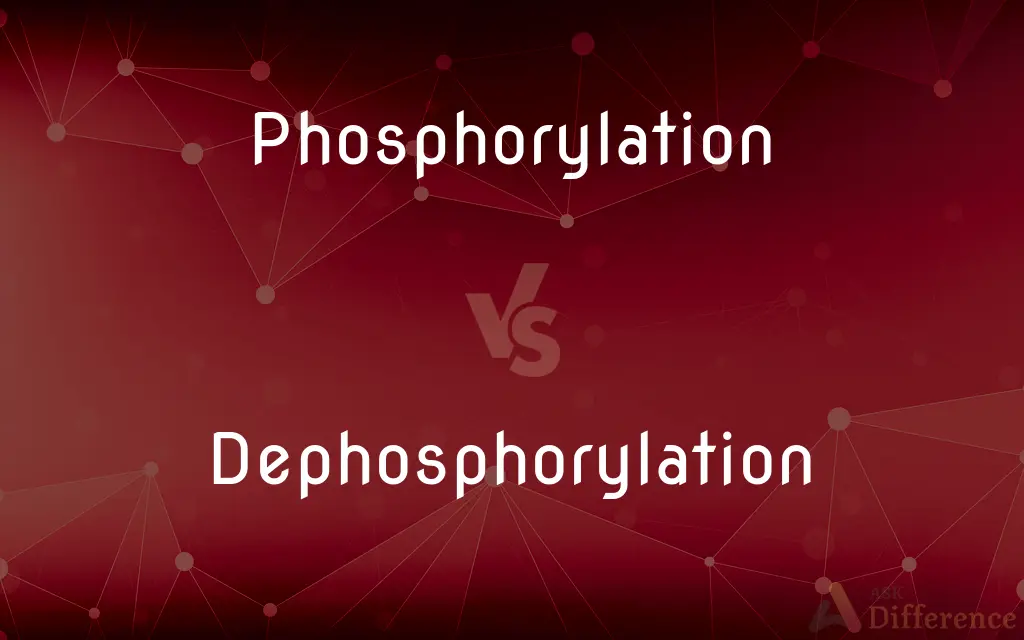Phosphorylation vs. Dephosphorylation — What's the Difference?
By Tayyaba Rehman & Urooj Arif — Updated on March 13, 2024
Phosphorylation adds a phosphate group to a molecule, enhancing its activity, while dephosphorylation removes it, often decreasing activity.

Difference Between Phosphorylation and Dephosphorylation
Table of Contents
ADVERTISEMENT
Key Differences
Phosphorylation is a crucial biochemical process involving the addition of a phosphate group to a protein or other organic molecule, which often alters the function or activity of the molecule. This modification can change the protein's structure, thereby affecting its role in cellular processes. On the other hand, dephosphorylation is the removal of a phosphate group, typically reversing the effects of phosphorylation. This process is equally important for regulating cellular functions, ensuring that activities within the cell are finely tuned in response to changing conditions.
While phosphorylation is often associated with the activation of enzymes and signaling pathways, leading to increased cellular activity or changes in cell behavior, dephosphorylation usually has the opposite effect. It often leads to the inactivation of proteins and serves as a mechanism to turn off signaling pathways, thus providing a balance to the cellular processes initiated by phosphorylation.
Phosphorylation is catalyzed by enzymes known as kinases, which are specialized for transferring a phosphate group from high-energy molecules, like ATP, to their substrates. Dephosphorylation, in contrast, is carried out by phosphatases, a distinct group of enzymes that remove phosphate groups, demonstrating the specialized nature of these regulatory processes.
The regulation of phosphorylation and dephosphorylation is critical for many cellular processes, including metabolism, cell cycle progression, and signal transduction. While phosphorylation can activate pathways leading to cell growth and division, dephosphorylation can act as a checkpoint, preventing unchecked cellular proliferation and potential diseases such as cancer.
The interplay between phosphorylation and dephosphorylation exemplifies the dynamic nature of cellular regulation, where the balance and timing of these processes are meticulously controlled to maintain cellular homeostasis and respond to environmental cues.
ADVERTISEMENT
Comparison Chart
Process
Addition of a phosphate group
Removal of a phosphate group
Enzymes Involved
Kinases
Phosphatases
Common Effect
Often activates or modifies proteins
Often deactivates or returns proteins to original state
Role in Cell
Can initiate or enhance cellular activities
Can terminate or reduce cellular activities
Significance
Critical for signal transduction, metabolism
Essential for turning off signals, maintaining balance
Compare with Definitions
Phosphorylation
It often activates enzymes and signaling pathways.
Phosphorylation plays a key role in cellular response mechanisms.
Dephosphorylation
Phosphatases are enzymes that catalyze dephosphorylation.
Specific phosphatases are recruited to dephosphorylate target proteins.
Phosphorylation
This process is reversible.
Phosphorylation's effects can be reversed by dephosphorylation.
Dephosphorylation
Dephosphorylation removes a phosphate group.
Dephosphorylation inactivated the previously stimulated enzyme.
Phosphorylation
Phosphorylation involves adding a phosphate group to a molecule.
The phosphorylation of the protein led to its activation.
Dephosphorylation
Dephosphorylation can restore a protein's original state.
The protein returned to its inactive form after dephosphorylation.
Phosphorylation
Kinases are the enzymes responsible for phosphorylation.
Kinases target specific proteins for phosphorylation.
Dephosphorylation
It often leads to the deactivation of proteins.
The signal transduction pathway was halted by dephosphorylation.
Phosphorylation
Phosphorylation can alter a protein's structure.
Phosphorylation induced a conformational change in the enzyme.
Dephosphorylation
It plays a role in turning off cellular signals.
Dephosphorylation served as a mechanism to cease the cellular response.
Phosphorylation
In chemistry, phosphorylation of a molecule is the attachment of a phosphoryl group. This process and its inverse, dephosphorylation, are critical for many cellular processes in biology.
Dephosphorylation
In biochemistry, dephosphorylation is the removal of a phosphate (PO43−) group from an organic compound by hydrolysis. It is a reversible post-translational modification.
Phosphorylation
To add a phosphate group to (an organic molecule).
Dephosphorylation
(biochemistry) The removal of phosphate groups from a compound, especially from a biological compound
Phosphorylation
(biochemistry) the process of transferring a phosphate group from a donor to an acceptor; often catalysed by enzymes.
Common Curiosities
What is phosphorylation?
Phosphorylation is the addition of a phosphate group to a molecule, often altering its function or activity.
What role does phosphorylation play in cells?
It activates or modifies proteins and enzymes, playing a crucial role in cellular processes like signal transduction and metabolism.
What enzymes catalyze phosphorylation?
Kinases are the enzymes responsible for phosphorylation.
Can the effects of phosphorylation be reversed?
Yes, the effects of phosphorylation can be reversed by the process of dephosphorylation.
What is dephosphorylation?
Dephosphorylation is the removal of a phosphate group from a molecule, often leading to the deactivation or return of proteins to their original state.
How do kinases and phosphatases regulate cellular activities?
Kinases and phosphatases regulate cellular activities by adding or removing phosphate groups from proteins, thus controlling their activity.
How does dephosphorylation affect cellular processes?
It often deactivates proteins and serves as a mechanism to turn off signaling pathways, maintaining cellular balance.
Is dephosphorylation necessary for cellular function?
Yes, it is essential for turning off signals and ensuring cellular processes do not remain perpetually active.
What is the significance of the balance between phosphorylation and dephosphorylation?
The balance is crucial for maintaining cellular homeostasis and responding appropriately to environmental cues.
What enzymes are involved in dephosphorylation?
Phosphatases are the enzymes that catalyze dephosphorylation.
Share Your Discovery

Previous Comparison
Grammar vs. Taxonomy
Next Comparison
Return vs. SendAuthor Spotlight
Written by
Tayyaba RehmanTayyaba Rehman is a distinguished writer, currently serving as a primary contributor to askdifference.com. As a researcher in semantics and etymology, Tayyaba's passion for the complexity of languages and their distinctions has found a perfect home on the platform. Tayyaba delves into the intricacies of language, distinguishing between commonly confused words and phrases, thereby providing clarity for readers worldwide.
Co-written by
Urooj ArifUrooj is a skilled content writer at Ask Difference, known for her exceptional ability to simplify complex topics into engaging and informative content. With a passion for research and a flair for clear, concise writing, she consistently delivers articles that resonate with our diverse audience.
















































